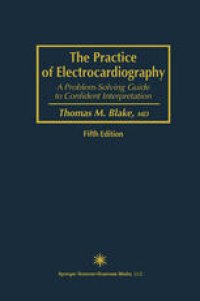
Ebook: The Practice of Electrocardiography: A Problem-Solving Guide to Confident Interpretation
Author: Thomas M. Blake MD (auth.)
- Tags: Cardiology
- Year: 1994
- Publisher: Humana Press
- Edition: 1
- Language: English
- pdf
Electrocardiography is a mature discipline, so familiar to both doctors and patients that it's hardly noticed, one of those tests that have always been there, like the white count and hemoglobin, not something one has to think about much, or question. To some extent this view is valid, but it overlooks some important points. Like the white count and hemoglobin, electrocardiograms are produced by technicians using mechanical devices that turn out numbers, but there is a difference. The white count and hemoglobin are reported as single values to be interpreted by the doctor who knows the patient and ordered the test, but the graph produced by an EKG machine represents millions of numbers displayed as XY plots, a message written in a language different from one's own. It requires transla tion, and this means that the translator must not only know the lan guage, but also be able to assess the effects on it of the many factors that may have modified its meaning between origin and delivery. There is potential for harm to the patient, as well as for help, in every facet of the process, and to lose sight of this, to see the tracing as a single whole, would be like seeing words as units without con sidering the letters that compose them. When we read, we do recog nize whole words, patterns, but, having learned the letters first, revert to this base intuitively when we encounter a new word, or one that is misspelled.
In The Practice of Electrocardiography, a master practitioner offers an organized approach to the art of EKG interpretation. Moving beyond the traditional approaches of many books that stress technical skill and pattern recognition, Dr. Blake shows how the four measurements needed to examine a tracing (orientation, duration, amplitude, and contour of each component) may be used with consistency and medical rigor for distinguishing normal and abnormal EKG patterns.
A unique worksheet guides the analytic process item by item and clarifies the logic of each stage of interpretation, in the same way that a dissection manual leads the student in an anatomy course. The result is a method for interpreting the electrocardiogram that reveals the anatomy and physiology behind each waveform and illuminates the gray areas between normal and abnormal.
The Practice of Electrocardiography provides a firm foundation in the diagnostic methods and clinical application of electrocardiography, as well as an entry into the literature through an outstanding bibliography. It will enable medical and nursing students to analyze the tracings they encounter in day-to-day practice with confidence and real understanding. Practicing clinicians will also find fresh insights here, and there are sections for technicians and their supervisors, as well as for administrators and others charged with assessing competence in the field.
After a lifetime of teaching and practicing EKG production and interpretation, after seeing more than a million EKG tracings over the years, Dr. Blake has distilled in The Practice of Electrocardiography the essence of his art and understanding for all those who must record tracings, interpret them, or judge an interpretation written by someone else.